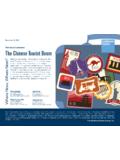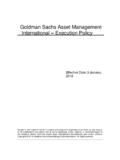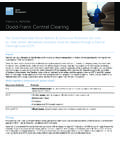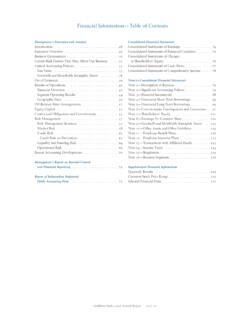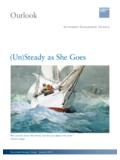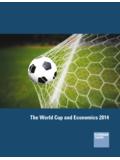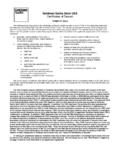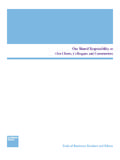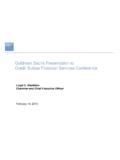Transcription of The Bigger Picture Black Womenomics - Goldman Sachs
1 The Bigger Picture | March 9, 2021 Black WOMENOMICSDaan Struyven Gizelle George-Joseph investing in the Underinvested The Goldman Sachs Group, Milo Executive Summary 3 Confronting the Wealth Gap 6 Earnings Gap 8 Education Gap 12 Capital Access Gap 15 Personal Finance Gap 19 Housing Gap 21 Health Gap 22 Actions to Invest in the Underinvested 27 Good for Growth 30 Fairer and Richer Society 31 Disclosure Appendix 32 9 March 2021 2 Goldman SachsThe Bigger PictureTable of Contents The Bigger Picture is a publication series from Goldman Sachs Global Investment Research devoted to longer-term economic and policy issues, which complements our more market-focused analysis. For other important disclosures, see the Disclosure WOMENOMICS2 Executive Summary 1. Black women face a 90% wealth gap. The economic and business case fordiversity will only grow as US demographics and the labor force are set to becomeincreasingly racially and ethnically diverse over the coming decades.
2 Yet, due to complexhistorical factors and ongoing discrimination, Black Americans and especially Blackwomen remain heavily disadvantaged across a broad range of economic measures,including wealth, earnings, and health. The median Black household owns nearly 90%less wealth than the median white household and the gap is even slightly larger forsingle Black women relative to single white men. The structural factors that havecreated and reinforced these economic disparities that Black women face aremultifaceted and interrelated, and inevitably we neglect many important issues. Thisstudy focuses on the wealth gap of Black women, its relationship with the broadereconomic disadvantages Black women face, and identifies public and private investmentopportunities to help close these Large earnings gap drives much of the wealth gap. Lower levels of earnings forBlack households account for about two-thirds of the average wealth gap, while theremainder is largely explained by financial factors, including access to capital andinvestment opportunities, personal finances, financial information, and housing.
3 Blackwomen make less in the labor market, primarily because they are paid significantly lessper hour and also because they are 10 percentage points less likely to be employed thanwhite men. The hourly earnings gap or wage gap of Black women stands at 15%relative to white women and 35% relative to white men. The wage gap of Black womenwidens through their whole work-life and especially rapidly between ages 20 and Earnings gap is widening again. Using a statistical model, we find that improvedaccess to better-paying occupations and industries drove a substantial narrowing in thewage gap of Black women relative to white men in the 80s and 90s. Unfortunately,progress in closing the wage gap of Black women vs. white men has stalled over thelast two decades. The wage gap of Black women relative to white women stood at 5%in the early 80s when it was largely explained by differences in education, occupations,and industries.
4 While these factors remain critical today, the wage gap has now grownto 15% on account of other harder-to-measure factors, which could capture differencesin career opportunities, school quality, or bias and discrimination. This underscores theneed to listen to Black women to fully understand their disadvantages and, critically, toaddress bias and Education gap. Black women have closed the racial high school completion gap andthe share of Black women with a college degree continues to rise. Despite thissignificant progress, the share with a college degree remains 10pp lower for Blackwomen relative to white women. Factors contributing to this educational attainmentgap include underinvestment in early childhood education, disparities in school funding,school quality, and economic resources, as well as bias faced by Black girls at estimate that closing the education gap for Black girls and women would narrow theearnings gap with white women by March 2021 3 Goldman SachsThe Bigger PictureExecutive SummaryBLACK WOMENOMICS35.
5 Capital access gap fuels wealth gap. Largely because of lower earnings and limitedaccess to capital, Black Americans are much less likely to own high-return assets thanwhite individuals, including homes, stocks, and especially their own businesses. Whilehomeownership typically yields strong financial returns, historical discriminatorypolicies, and racial disparities in credit history and in family assistance have limited theability of Black women to build real estate wealth. The median single Black womandoes not own a home and single Black women are 24 times less likely than single whitemen to own a business. The fact that Black women entrepreneurs cite limited access tofunds as the largest barrier to success and that Black entrepreneurs are 20% less likelyto fund their startups with bank business loans suggest that capital access gapscontribute to the business ownership gap. Moreover, single Black women are fourtimes less likely to inherit assets than single white men, which further perpetuates thewealth gap across Personal finances gap.
6 Black women s wealth is not only held down by a loweraccess to high-return assets, but also by a higher exposure to high-cost liabilities. Blackwomen are, for instance, five times more likely than white men to rely on expensivepayday loans, likely due to limited access to formal credit and potentially financialinformation gaps. Survey evidence on compound interest and familiarity with stockmarket risk suggest that Black women face a financial information Housing gap. Partly due to the home ownership gap, Black women face asubstantial housing quality gap, with one-third of the homes occupied by Black womenestimated to be unhealthy. The fact that 55% of Black women in renting households are rent burdened spending 30% or more of income on rent further illustrates thechallenge of affording quality housing while saving and Health gap. Last but not least, Black women experience less favorable healthoutcomes, partly due to reduced access to quality care.
7 Black women are 35% morelikely to report fair or poor health, and have a pregnancy-related mortality rate that ismore than three times higher than white women. The racial disparities are alsoespecially large for breast cancer, and pain undertreatment. Consistent with majoraccess issues, Black women are nearly three times more likely to forego prescriptionmedicine and also much more likely not to see a doctor than white men because theycannot afford it. The fact that Black women are one-third more likely to cite healthissues as a barrier to work than white individuals suggests that closing the health gapwould also narrow the earnings and wealth Solutions to close the gaps. Changing the economic disadvantages that Blackwomen face is a multidimensional commitment across the public and private sectorsand efforts to effectively address the issues can only succeed if Black women areactively engaged in formulating the strategies and framing the outcomes.
8 It is criticalthat the public sector continues to robustly address racial inequity and mandate changesto laws and policies that influence behavior and close the gaps over time. We highlightthe power of private capital in driving progress toward economic equity for Blackwomen, their families, and their communities. These strategies focus on intentionalstructural adjustments and investments to compensate in part for the systematicbarriers that have been so fundamental in creating the broad disparities that Black9 March 2021 4 Goldman SachsThe Bigger PictureBLACK WOMENOMICS4women continue to face today: 1) reduce barriers to college education and increase graduation rates for Black women, 2) provide access to capital for Black women entrepreneurs, 3) increase financial education and, 4) invest in Black communities, including in affordable housing, quality healthcare, and suitable childcare facilities in primarily Black neighborhoods.
9 Black women are often at the center of advocating for their own equality and progress. The proposed actions focus on lowering barriers and creating pathways to economic security. 10. Good for growth. Overcoming these adverse economic trends would make for notonly a fairer, but also a richer society. We estimate that confronting the earnings gap forBlack women could create million US jobs, and raise the level of annual US GDPby each year, or $300-450bn in current would like to thank Jan Hatzius for his guidance throughout the project and Joseph Briggs for his helpful suggestions and comments. Kathy Matsui in her role as GS Chief Japan Portfolio Strategist coined the term Women-omics in the seminal 1999 study on the impact of female empowerment on the labor market, GDP growth, and financial markets in Japan. See Kathy Matsui, Hiromi Suzuki, and Yoko Ushio, Women-omics. Buy the Female Economy , August 13, March 2021 5 Goldman SachsThe Bigger PictureBLACK WOMENOMICS5 Confronting the Wealth Gap Black Americans and especially Black women remain heavily disadvantaged across a broad range of economic measures, including wealth, earnings, and health.
10 The left panel of Exhibit 1 shows that the Black -white wealth gap has remained very large over the past 30 years. Data from the Survey of Consumer Finances (SCF) show that the median Black household had a net wealth of $24,000 in 2019, or nearly 90% less than the median white household. Single Black women have an especially low median net wealth of just $7,000 (right panel). The large wealth gap faced by single Black women is particularly important because Black women are more and increasingly likely to be single and breadwinner mothers. The marriage rate of Americans aged 25-54 has declined since the early 60s across all groups, but especially for Black women for whom it has halved to less than 40% (Exhibit 2, left panel).2 The right panel shows that around one-third of Black women aged 25-54 are single with children in the household. Among Black mothers, more than 80% are breadwinners compared to 50% of white 2 The lower marriage rate of Black individuals does not reflect differences in cohabitation rates because Black and white adults have a similar cohabitation rate of around 7%.
